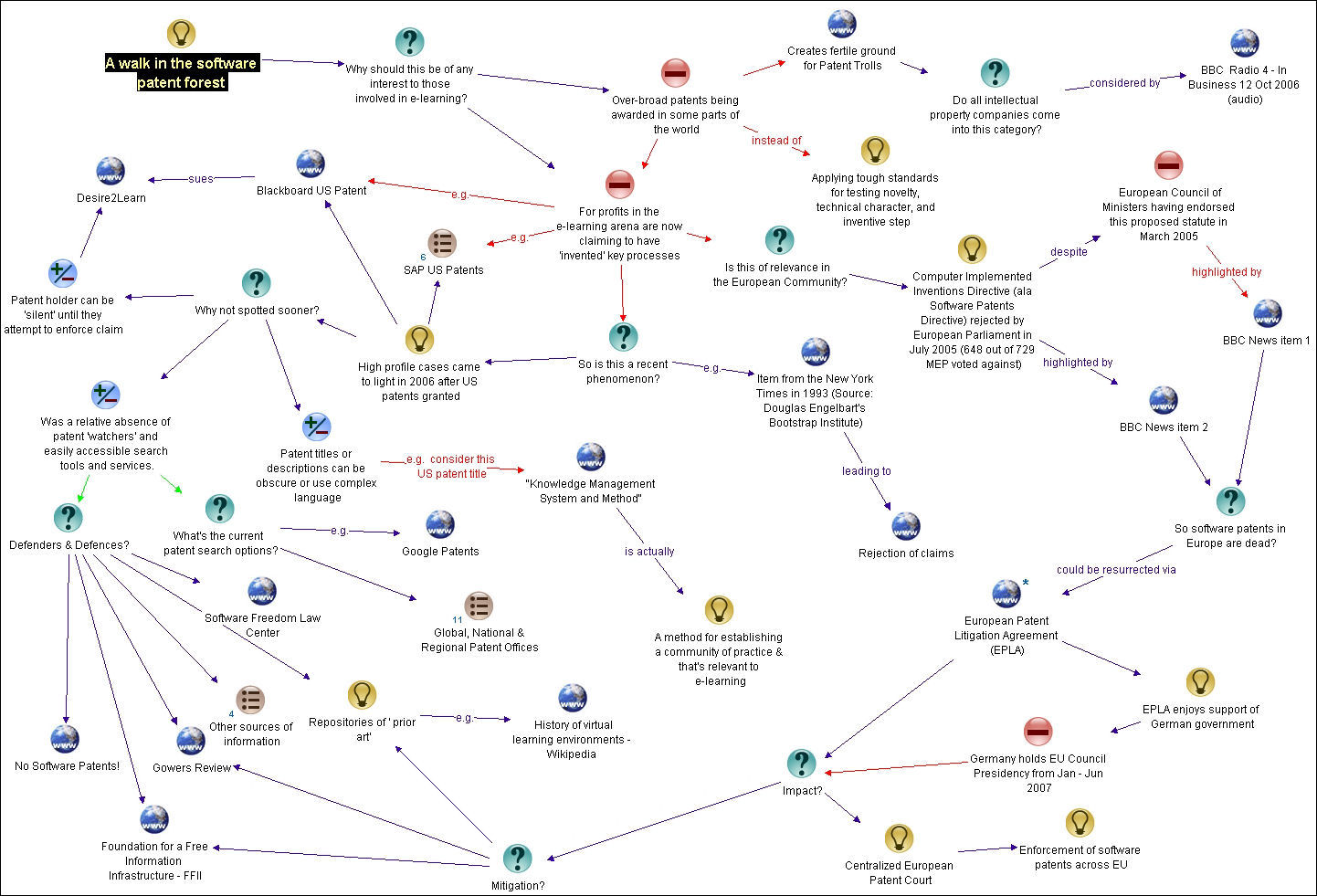Yesterday’s part 1 of the sofware patent topic took a fairly conventional quasi essay format. Today, however, I’m offering a concept map visualisation of the topic.
My reasons for offering this alternative visualisation of the software patents and e-learning issue are two-fold. First, it enabled me to exercise version 1.5.1 Beta 2 of Compendium an excellent piece of software which is a joint development of the UK OU Knowledge Media Institute and Verizon. Second, I wanted to see if these alternative approaches to researching and presenting the topic would influence each other.
I’m a big fan of cognitive tools like mind-mapping and concept mapping software. I’ve previously used the University of West Florida’s Insitute for Human and Machine Cognition’s CMapTools and have made use of MindJet’s MindManager software. The latter I don’t consider as good or as flexible as the free options but it’s what the Higher Education Academy uses and so its useful when working on internal projects with colleagues.
I quite like Compendium and would certainly use it again. I daresay I could improve on my first attempt and that some may want to take issue with how I’ve modeled the software patents in e-learning topic. Before getting down to what I’ve produced however, I would like to try and answer my second reason for modeling the topic as a concept, i.e. did it influence yesterday’s posting? The simple answer is yes it did.
I created the basic skeletion of part 1 as text narrative when in turn provided the basic infrastructure for the concept map. But, by modeling the problem area as a concept map I could see some flaws in the structure and elements of the ‘story’ I wished to tell. For example, in the concept map some things were better posed as a question which I would then seek answer to or ask subsidiary questions of. The concept map also helped me visualize relationships, e.g. between the pro and anti software patent entities. As a result I went back to the text narrative of part 1 and modify it significantly. The active nodes of the concept map are also immensely useful because it becomes possible to tunnel into some of the information or perspectives represented by the concept map nodes.
Creating a Compendium concept map means installing its Java client (Java has recently become open source). Despite the Java client its export options are pretty good. I’ve used most of these for the downloads I’m offering. First up is its static jpeg export. There’s no active nodes in the jpeg export but its still useful for illustrative purposes or making paper copies.

N.B. You can view the high resolution version of thumbnail image above by clicking the right button on your mouse and then choosing the appropriate viewing option for your browser.
I’ve packaged various version of the jpeg file and other Compendium elements in a SoftwarePatents.zip file which users can download. Expand all of the files and folders into a folder on your local computer.
I would encourage Auricle readers to download a copy of Compendium so that they can make use of the softwarepatents.xml included in the zip. XML is one of the export formats offered by Compendium and it facilitates sharing and group working. Users with their own copy of Compendium can import the XML file and thus amend or enhance my concept map.
For those users without a copy of Compendium the zip file also offers a web map version of my concept map. Although this is not editable it does offer most of the features of the Compendium Java client including active nodes. If you don’t want a table of contents page in this option then just click the Software_Patents_192168061167041192453.html file after you’ve transferred the whole filestructure from the zip to your local computer.
I’m not saying the above is necessarily the best example of a concept map or that both postings necessarily add anything new to our understanding of the issues but hopefully the downloads will prove to be a useful resource for at least a few readers.
The above are offered on a Creative Commons license (attribution and sharealike) so if you do modify or reuse any of the above I would appreciate a copy and information about your repurposing or reuse.
Happy New Year!

